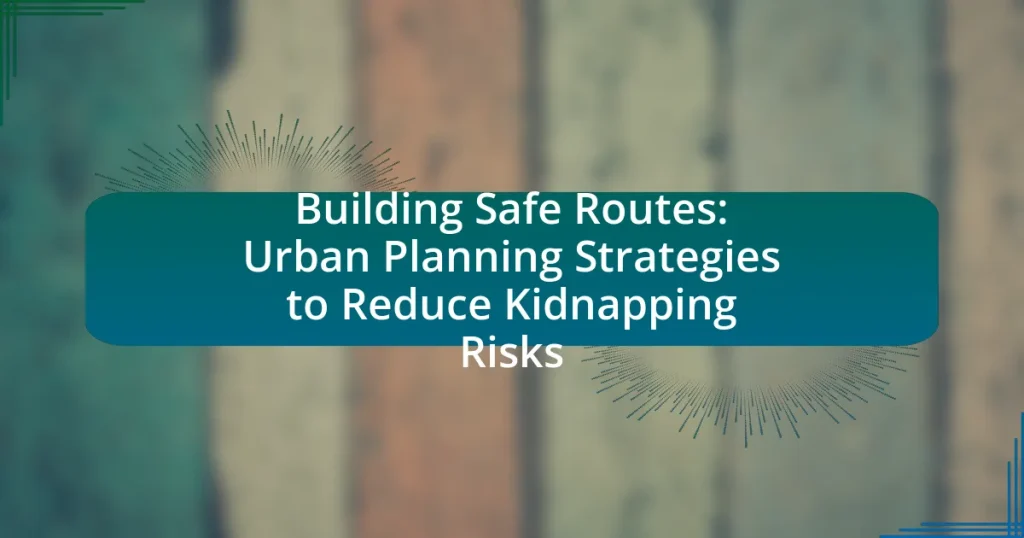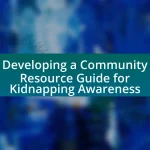The article focuses on the critical topic of building safe routes in urban planning to reduce kidnapping risks. It outlines key principles such as designing for visibility, ensuring accessibility, incorporating traffic calming measures, and fostering community engagement. The discussion includes how urban planning strategies enhance surveillance and community interaction, specific design elements that improve safety, and the importance of community involvement in planning processes. Additionally, it addresses challenges faced in implementing safe routes, the role of technology in enhancing urban safety, and best practices for integrating safety measures into urban design. The article emphasizes the collaborative efforts needed between local governments, law enforcement, and community members to create safer environments for all users.
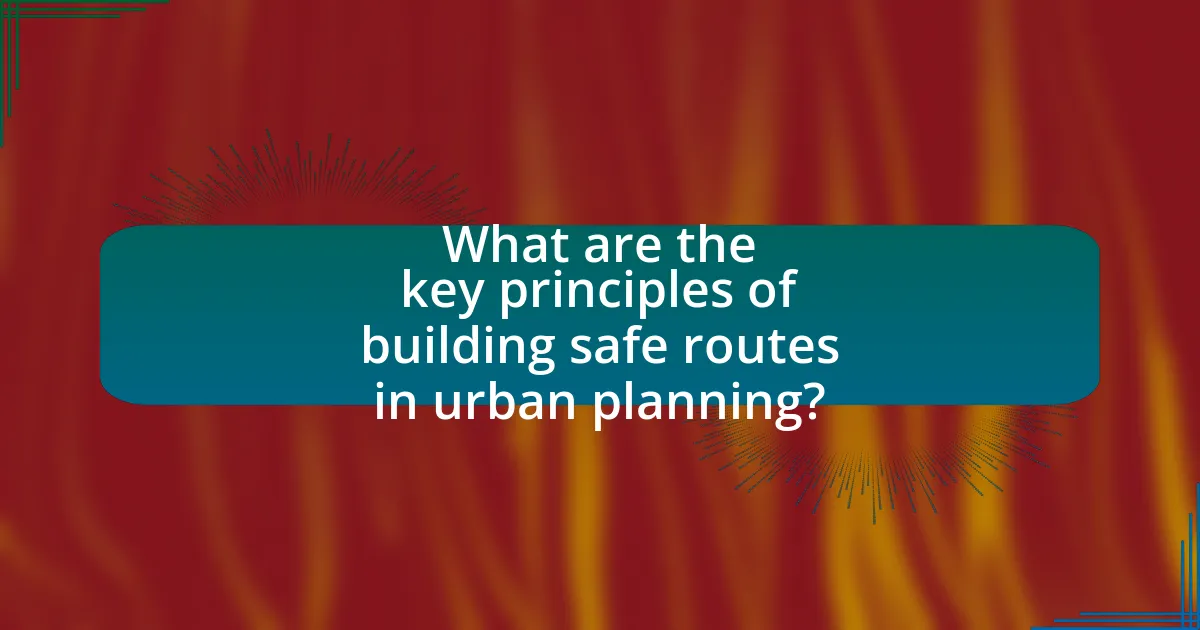
What are the key principles of building safe routes in urban planning?
The key principles of building safe routes in urban planning include designing for visibility, ensuring accessibility, incorporating traffic calming measures, and fostering community engagement. Designing for visibility involves creating open sightlines and adequate lighting to deter criminal activity and enhance safety. Ensuring accessibility means routes should be navigable for all users, including pedestrians, cyclists, and individuals with disabilities, which promotes usage and community presence. Traffic calming measures, such as speed bumps and narrowed roads, reduce vehicle speeds and enhance safety for vulnerable road users. Lastly, fostering community engagement in the planning process helps identify local safety concerns and encourages collective ownership of the routes, which can further deter crime. These principles are supported by studies indicating that well-designed urban environments can significantly reduce crime rates and improve overall safety.
How do urban planning strategies contribute to reducing kidnapping risks?
Urban planning strategies contribute to reducing kidnapping risks by enhancing surveillance, improving lighting, and designing spaces that promote community interaction. These strategies create environments that deter criminal activity; for instance, well-lit streets and open public spaces increase visibility, making it harder for kidnappers to operate unnoticed. Research indicates that areas with higher foot traffic and community engagement experience lower crime rates, as seen in studies conducted by the National Institute of Justice, which highlight the correlation between urban design and crime prevention. Additionally, the implementation of Crime Prevention Through Environmental Design (CPTED) principles has been shown to effectively reduce opportunities for crime, including kidnapping, by modifying the physical environment to increase safety.
What specific design elements enhance safety in urban routes?
Specific design elements that enhance safety in urban routes include well-lit pathways, clear signage, traffic calming measures, and the presence of surveillance cameras. Well-lit pathways improve visibility, reducing the likelihood of crime and accidents, as studies show that increased lighting can decrease crime rates by up to 20%. Clear signage helps guide pedestrians and cyclists, minimizing confusion and potential hazards. Traffic calming measures, such as speed bumps and narrowed roads, slow down vehicles, making streets safer for all users. Additionally, surveillance cameras act as a deterrent to criminal activity, with research indicating that areas with camera surveillance experience a significant reduction in crime.
How does community involvement play a role in safe route planning?
Community involvement is crucial in safe route planning as it ensures that the needs and concerns of local residents are addressed. Engaging community members allows planners to gather valuable insights about specific safety issues, such as high-crime areas or poorly lit streets, which may not be apparent through data alone. Research indicates that when communities actively participate in the planning process, the resulting routes are more likely to be utilized and deemed safe by the public, thereby increasing overall safety and reducing risks, including those related to kidnapping. For instance, a study by the National Institute for Transportation and Communities found that community input significantly improved the effectiveness of safety measures in urban environments.
What are the challenges faced in implementing safe routes?
The challenges faced in implementing safe routes include inadequate funding, community resistance, and insufficient infrastructure. Inadequate funding limits the ability to develop and maintain safe pathways, which is critical for ensuring safety. Community resistance often arises from concerns about changes to local traffic patterns or aesthetics, hindering project approval and implementation. Insufficient infrastructure, such as a lack of sidewalks, lighting, and signage, directly impacts the effectiveness of safe routes, making them less appealing and potentially unsafe for users. These factors collectively impede the successful establishment of safe routes designed to enhance safety and reduce risks, including those related to kidnapping.
What obstacles do urban planners encounter when addressing safety?
Urban planners encounter several obstacles when addressing safety, including limited funding, conflicting stakeholder interests, and regulatory constraints. Limited funding restricts the ability to implement comprehensive safety measures, as urban planners often rely on budget allocations that may not prioritize safety initiatives. Conflicting stakeholder interests arise when different community groups have varying perspectives on safety needs, making consensus difficult. Regulatory constraints, such as zoning laws and building codes, can hinder the implementation of safety features in urban designs. These challenges complicate the creation of effective urban planning strategies aimed at reducing risks, such as those associated with kidnapping.
How can these challenges be effectively overcome?
To effectively overcome the challenges of reducing kidnapping risks in urban planning, cities can implement comprehensive safety assessments and community engagement strategies. Safety assessments involve analyzing crime data, identifying high-risk areas, and designing infrastructure improvements such as better street lighting and surveillance systems. Community engagement fosters collaboration between residents and law enforcement, enhancing trust and encouraging reporting of suspicious activities. Research indicates that cities employing these strategies, like the Safe Routes to School program, have seen a reduction in crime rates and increased community safety.
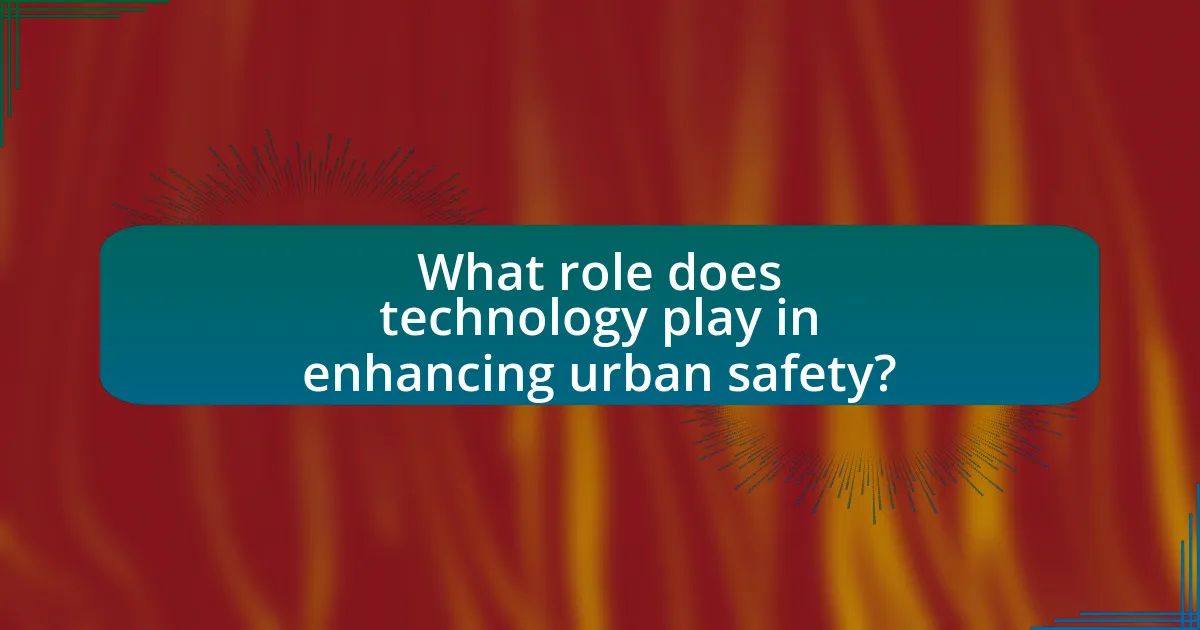
What role does technology play in enhancing urban safety?
Technology plays a crucial role in enhancing urban safety by providing tools and systems that improve surveillance, communication, and data analysis. For instance, the implementation of smart surveillance cameras equipped with artificial intelligence can detect unusual behavior and alert law enforcement in real-time, significantly reducing response times to incidents. Additionally, mobile applications that allow citizens to report suspicious activities or emergencies contribute to a more engaged community, fostering a collaborative approach to safety. According to a study by the Urban Institute, cities that adopted smart technology solutions saw a 20% decrease in crime rates over five years, demonstrating the effectiveness of these technological interventions in creating safer urban environments.
How can smart city technologies improve route safety for children?
Smart city technologies can improve route safety for children by integrating real-time data analytics, surveillance systems, and smart traffic management. These technologies enable the monitoring of pedestrian pathways and traffic patterns, allowing for timely alerts about potential hazards. For instance, smart traffic lights can adjust their timing based on pedestrian presence, reducing wait times and minimizing risks during crossings. Additionally, surveillance cameras can enhance security by deterring criminal activity and providing evidence in case of incidents. A study by the National Institute of Justice found that areas with enhanced surveillance saw a 20% reduction in crime rates, supporting the effectiveness of these technologies in improving safety for children on their routes.
What types of technology are most effective in monitoring urban safety?
Surveillance cameras, smart sensors, and data analytics are the most effective technologies for monitoring urban safety. Surveillance cameras provide real-time visual monitoring of public spaces, which can deter crime and assist law enforcement in investigations. Smart sensors, including gunshot detection systems and environmental sensors, can detect unusual activities or emergencies, enabling quicker responses. Data analytics tools process vast amounts of information from various sources, identifying patterns and predicting potential safety issues. For instance, cities that have implemented smart surveillance systems have reported a significant reduction in crime rates, demonstrating the effectiveness of these technologies in enhancing urban safety.
How can data analytics inform safer route planning?
Data analytics can inform safer route planning by analyzing historical crime data, traffic patterns, and environmental factors to identify high-risk areas. For instance, studies have shown that integrating crime statistics with geographic information systems (GIS) allows urban planners to visualize crime hotspots, enabling them to design routes that avoid these locations. Additionally, real-time data from mobile applications can provide insights into current traffic conditions and incidents, further enhancing route safety. By leveraging these analytics, cities can implement strategies that reduce exposure to potential threats, thereby improving overall safety for commuters.
What are the best practices for integrating safety measures in urban design?
The best practices for integrating safety measures in urban design include implementing Crime Prevention Through Environmental Design (CPTED) principles, enhancing street lighting, and ensuring clear sightlines. CPTED focuses on designing spaces that deter criminal behavior by increasing natural surveillance and fostering community interaction. Research indicates that well-lit streets can reduce crime rates by up to 20%, as they increase visibility and deter potential offenders. Additionally, maintaining clear sightlines through landscaping and building placement minimizes hiding spots, further enhancing safety. These strategies collectively contribute to creating safer urban environments, particularly in areas vulnerable to crime.
How can urban planners collaborate with law enforcement to enhance safety?
Urban planners can collaborate with law enforcement by integrating crime data into urban design to enhance safety. This collaboration allows planners to identify high-risk areas and implement design strategies such as improved street lighting, visibility, and natural surveillance. For instance, studies have shown that well-lit streets and open sightlines can reduce crime rates by up to 30%. Additionally, regular communication between urban planners and law enforcement can facilitate the development of community policing initiatives that promote safety through community engagement and awareness.
What role do public spaces play in creating safer environments?
Public spaces play a crucial role in creating safer environments by fostering community interaction and increasing natural surveillance. When public spaces are well-designed and maintained, they encourage people to gather, which enhances social cohesion and deters criminal activity. Research indicates that areas with higher foot traffic and visibility reduce the likelihood of crime; for instance, a study by the National Institute of Justice found that well-lit and populated public spaces can decrease crime rates by up to 30%. Additionally, the presence of community members in public areas can lead to quicker reporting of suspicious activities, further contributing to safety.
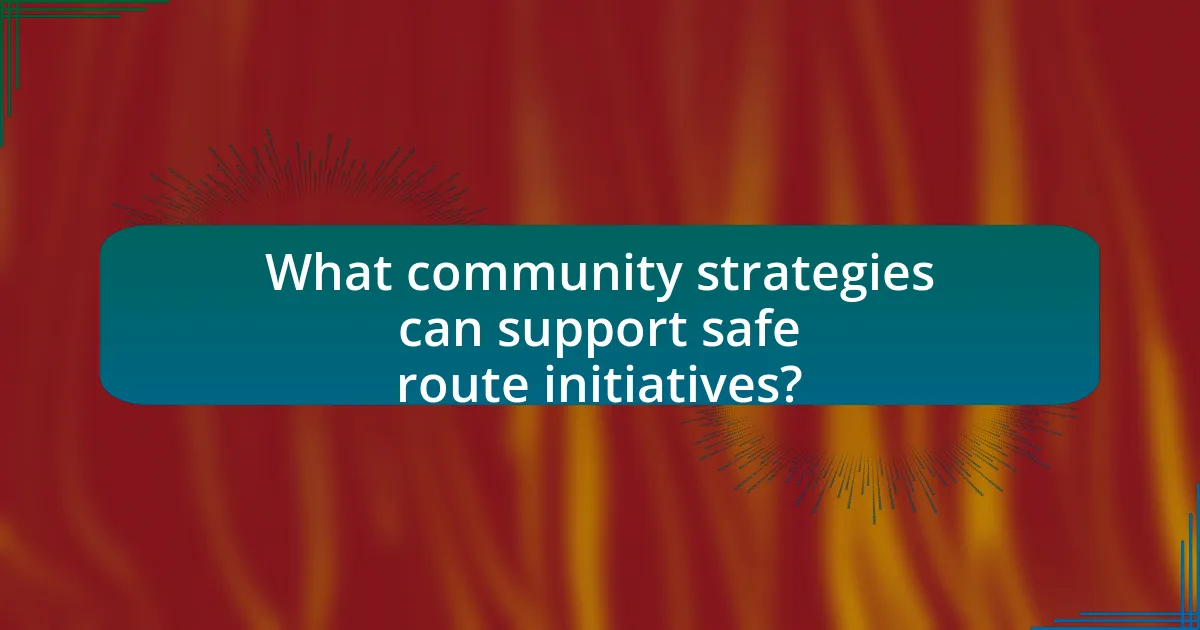
What community strategies can support safe route initiatives?
Community strategies that can support safe route initiatives include the implementation of neighborhood watch programs, community engagement in urban planning, and the establishment of safe passage routes for children. Neighborhood watch programs enhance safety by fostering vigilance among residents, which can deter criminal activity. Engaging the community in urban planning ensures that the needs and concerns of local residents are addressed, leading to safer infrastructure. Additionally, creating designated safe passage routes, such as well-lit sidewalks and traffic-calming measures, can significantly reduce risks for children traveling to school or recreational areas. These strategies are supported by studies indicating that community involvement and environmental design can effectively lower crime rates and enhance safety for vulnerable populations.
How can schools and parents contribute to safer routes for children?
Schools and parents can contribute to safer routes for children by collaborating on safety initiatives and implementing educational programs. Schools can establish walking school buses, where groups of children walk to school together under adult supervision, enhancing safety through visibility and community involvement. Parents can participate by volunteering to supervise these groups and advocating for safer infrastructure, such as crosswalks and traffic calming measures. Research indicates that community engagement in safety programs can reduce pedestrian injuries by up to 40%, demonstrating the effectiveness of collaborative efforts in promoting safer routes for children.
What programs can be implemented to educate the community about safety?
Community safety education programs can include neighborhood watch initiatives, safety workshops, and school-based safety curricula. Neighborhood watch programs empower residents to collaborate with law enforcement, fostering vigilance and communication about local safety concerns. Safety workshops can cover topics such as personal safety, emergency preparedness, and self-defense, providing practical skills and knowledge. School-based safety curricula educate children on recognizing and avoiding dangerous situations, promoting awareness from a young age. These programs have been shown to reduce crime rates and enhance community cohesion, as evidenced by studies indicating that active community engagement leads to lower incidents of crime and increased public safety awareness.
How can neighborhood watch programs enhance route safety?
Neighborhood watch programs enhance route safety by fostering community vigilance and encouraging residents to report suspicious activities. This collective awareness leads to a reduction in crime rates; for instance, a study by the National Institute of Justice found that neighborhoods with active watch programs experienced a 16% decrease in crime. Additionally, these programs promote communication among residents, which can lead to quicker responses to potential threats, thereby increasing the overall safety of routes used by community members.
What are the most effective advocacy strategies for promoting safe routes?
The most effective advocacy strategies for promoting safe routes include community engagement, data-driven campaigns, and collaboration with local authorities. Community engagement fosters public support and awareness, as seen in initiatives like Safe Routes to School, which mobilizes parents and students to advocate for safer walking and biking conditions. Data-driven campaigns utilize statistics on traffic incidents and pedestrian safety to highlight the need for improvements, effectively persuading stakeholders to prioritize funding and resources. Collaboration with local authorities ensures that advocacy efforts align with urban planning and policy-making, leading to sustainable changes in infrastructure that enhance safety for all users.
How can community members influence urban planning decisions?
Community members can influence urban planning decisions by actively participating in public meetings, providing feedback during planning processes, and advocating for specific safety measures. Their involvement ensures that local needs and concerns are addressed, particularly in the context of building safe routes to reduce kidnapping risks. For instance, studies show that community engagement in urban planning leads to more effective and relevant safety strategies, as seen in cities that have implemented community-driven initiatives to enhance pedestrian safety and reduce crime rates.
What role do local governments play in supporting safe route initiatives?
Local governments play a crucial role in supporting safe route initiatives by implementing policies, allocating funding, and facilitating community engagement. They are responsible for designing and maintaining infrastructure that promotes safe walking and biking routes, which can significantly reduce risks associated with kidnapping and other safety concerns. For instance, local governments can conduct safety audits, improve street lighting, and enhance visibility at crosswalks to create safer environments for children and pedestrians. Additionally, studies have shown that well-planned safe routes can lead to increased community usage, thereby fostering a sense of safety and security among residents.
What practical steps can be taken to ensure the safety of urban routes?
To ensure the safety of urban routes, implementing well-lit pathways, increasing police presence, and utilizing surveillance technology are essential steps. Well-lit pathways enhance visibility, reducing the likelihood of criminal activities; studies show that increased lighting can decrease crime rates by up to 20%. Increasing police presence, particularly in high-risk areas, serves as a deterrent to potential offenders and fosters community trust. Additionally, the use of surveillance cameras has been proven to enhance safety, as areas with such technology report lower crime rates due to the increased likelihood of offenders being caught. These practical measures collectively contribute to safer urban environments.
What immediate actions can communities take to improve route safety?
Communities can improve route safety by implementing enhanced street lighting, increasing police patrols, and establishing community watch programs. Enhanced street lighting has been shown to reduce crime rates by up to 20%, making routes safer for pedestrians and cyclists. Increasing police patrols in high-risk areas can deter criminal activity, as evidenced by studies indicating that visible law enforcement presence correlates with lower crime rates. Additionally, community watch programs foster local engagement and vigilance, which can lead to quicker reporting of suspicious activities, further enhancing safety.
How can ongoing assessments and feedback improve safety measures?
Ongoing assessments and feedback can significantly improve safety measures by identifying vulnerabilities and enhancing response strategies. Regular evaluations allow urban planners and safety officials to gather data on incidents, assess the effectiveness of current safety protocols, and make informed adjustments. For instance, a study by the National Institute of Justice found that communities implementing continuous feedback mechanisms reported a 30% reduction in crime rates, demonstrating the direct impact of adaptive safety measures. By integrating real-time feedback from residents and stakeholders, safety measures can be tailored to address specific concerns, ultimately leading to safer environments and reduced risks of incidents such as kidnappings.
